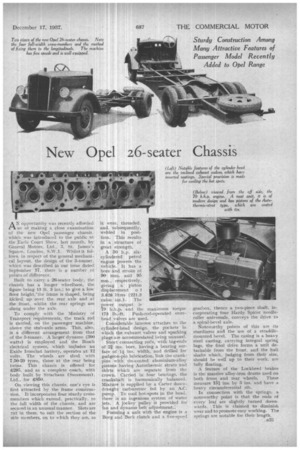New Opel 26-seater Chassis
Page 23

If you've noticed an error in this article please click here to report it so we can fix it.
A'opportunity was recently afforded us of making a close examination of the new Opel passenger chassis, which was introduced to the public at the Earls Court Show, last month, by General Motors, Ltd., 3, St. James's Square, London, SAVA.. Whilst it follows, in respect of the general mechanical layout, the design of the 3-tonner, which was described in our issue dated September 17, there "is a number of points of difference.
Built to carry a 26-seater body, the chassis has a longer wheelbase, the figure being 15 ft. 3 ins.; to give a low floor height,•the frame is shaped, being kicked up over the rear axle and at the front, whilst the rear springs are slung under the axle.
To comply with the Ministry of Transport requirements, the track rod is carried, on the passenger machine, above the stub-axle arms. This, also, is a different arrangement from that of the 3-tonner. A larger dynamo (300 watts) is employed and the Bosch electrical system; which includes an Exicle Ironclad battery, operates at 12 volts. The wheels are shod with 7.50-20 tyres, those at the rear being twins. This chassis is offered for £295, and as a complete coach, with body built by Strachans (Successors), Ltd., for £850.
On viewing this chassis, one's eye is first attracted by the frame construction. It incorpoiates four sturdy crossmembers which extend, practically, to the full width of the chassis, and are secured in an unusual manner. Slots are r.tut in them, to suit the section of the side members, on to which they are, as it were, threaded, and, subsequently, welded in position. This results in a . structure of great strength.
A 30 h.p. sixcylindered petrol engine powers the vehicle. It has a bore and stroke of 90 mm. and 95 mm., respectively, giving , a piston displacement o 3.626 litres (221.3 cubic ins.). The power output is 79 b,h.p. and the maximum torque 173 lb.-ft. Push-rod-operated overhead valves are used.
Considerable interest attaches to the cylinder-head design, the pockets in which the exhaust valves and sparking plugs are accommodated being unusual.
Short connecting rods, with big-ends of 21 ins, bore, having a bearing surface of 14 ins, width, and drilled for gudgeon-pin lubrication, link the crankpins with tin-coated aluminium-alloy pistons having Autotherrnic struts and skirts which are separate from the crown. Carried in four bearings, the crankshaft is harmonically balanced. Mixture is supplied by. a Carter downdraught carburetter fed by an A.C. pump. To cool hot-spots in the head, there is an ingenious system of water jets. A jockey pulley is provided for fan and dynamo belt adjustment::
Forming a unit with the engine is a Borg and Beck clutch and a five-speed .gearbox, thence a two-piece shaft, incorporating four Hardy Spicer needleroller universals, conveys the drive to a spiral-bevel axle.
Noteworthy points of this are its sturdiness and the use of a straddlemounted bevel. The casing is a heavy steel casting, carrying integral spring lugs, the final drive forms a unit detachable from the front, and the half shafts which, judging from their size, should be well up to their work. are fully floating.
A feature of the Lockheed brakes is the massive alloy-iron drums used on
both front and rear wheels. These measure 151-ins. by 3 ins, and have a heavy circumferential rib.
In connection with the springs, a noteworthy point is that the ends of 'every leaf are slightly turned down. wards. This is claimed to diminish wear and to promote easy working. The springs are notable for their-length.




























